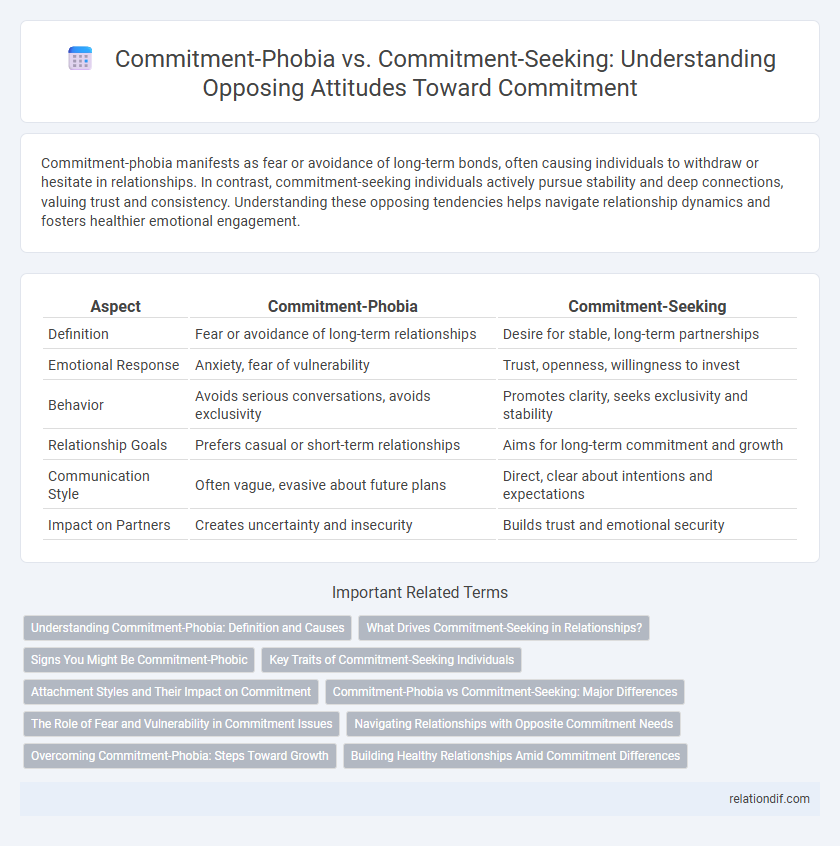Commitment-phobia manifests as fear or avoidance of long-term bonds, often causing individuals to withdraw or hesitate in relationships. In contrast, commitment-seeking individuals actively pursue stability and deep connections, valuing trust and consistency. Understanding these opposing tendencies helps navigate relationship dynamics and fosters healthier emotional engagement.
Table of Comparison
| Aspect | Commitment-Phobia | Commitment-Seeking |
|---|---|---|
| Definition | Fear or avoidance of long-term relationships | Desire for stable, long-term partnerships |
| Emotional Response | Anxiety, fear of vulnerability | Trust, openness, willingness to invest |
| Behavior | Avoids serious conversations, avoids exclusivity | Promotes clarity, seeks exclusivity and stability |
| Relationship Goals | Prefers casual or short-term relationships | Aims for long-term commitment and growth |
| Communication Style | Often vague, evasive about future plans | Direct, clear about intentions and expectations |
| Impact on Partners | Creates uncertainty and insecurity | Builds trust and emotional security |
Understanding Commitment-Phobia: Definition and Causes
Commitment-phobia refers to the intense fear or avoidance of long-term emotional or relational commitments, often rooted in past traumas, attachment issues, or fear of vulnerability. Individuals with commitment-phobia may experience anxiety, distrust, or apprehension when facing intimacy or future planning in relationships. Understanding the psychological and emotional factors behind commitment-phobia is crucial for addressing avoidance behaviors and fostering healthier, commitment-seeking attitudes.
What Drives Commitment-Seeking in Relationships?
Commitment-seeking in relationships is driven by emotional security, trust, and a desire for long-term connection. Individuals motivated by attachment needs prioritize stability and mutual support, fostering deeper bond formation. Positive past experiences and healthy communication patterns also reinforce the willingness to commit.
Signs You Might Be Commitment-Phobic
Avoidance of long-term plans, frequent relationship doubts, and discomfort with emotional intimacy are clear signs you might be commitment-phobic. Consistently prioritizing personal freedom over relationship growth often indicates fear of being tied down. Recognizing these behaviors early helps address underlying anxieties and fosters healthier connection patterns.
Key Traits of Commitment-Seeking Individuals
Commitment-seeking individuals exhibit key traits such as emotional availability, clear communication, and a strong desire for long-term partnership. They prioritize trust-building, demonstrate reliability through consistent actions, and show readiness to invest time and effort into nurturing the relationship. These characteristics foster stability and deep connection, distinguishing them from commitment-phobic counterparts who often avoid intimacy and long-term bonds.
Attachment Styles and Their Impact on Commitment
Attachment styles significantly influence commitment behavior, with secure attachment fostering commitment-seeking tendencies through trust and emotional availability. In contrast, avoidant attachment often leads to commitment-phobia due to fear of intimacy and dependence. Anxious attachment can cause fluctuating commitment patterns, driven by the desire for closeness coupled with fear of rejection.
Commitment-Phobia vs Commitment-Seeking: Major Differences
Commitment-phobia involves an intense fear of long-term attachment fueled by anxiety and past relational traumas, leading to avoidance of deep emotional bonds. Commitment-seeking individuals prioritize stability, trust, and long-term connection, actively fostering intimacy and mutual growth in relationships. Key differences include emotional readiness, communication styles, and willingness to invest effort in sustaining partnerships.
The Role of Fear and Vulnerability in Commitment Issues
Fear of vulnerability often drives commitment-phobia, as individuals resist emotional exposure and potential rejection. In contrast, commitment-seeking individuals embrace vulnerability, viewing it as a pathway to deeper connection and trust. Understanding the psychological interplay between fear and openness is crucial in addressing commitment issues and fostering healthy relationships.
Navigating Relationships with Opposite Commitment Needs
Navigating relationships with opposing commitment needs requires understanding the psychological roots of commitment-phobia, such as fear of vulnerability and loss of autonomy, contrasted with commitment-seeking behaviors driven by a desire for security and emotional connection. Effective communication and empathy can bridge the gap between a commitment-phobic partner's need for space and a commitment-seeking partner's need for reassurance. Developing mutual respect and establishing clear boundaries helps balance these differing needs, fostering relationship growth despite contrasting commitment approaches.
Overcoming Commitment-Phobia: Steps Toward Growth
Overcoming commitment-phobia involves recognizing and addressing underlying fears such as vulnerability and loss of independence. Developing emotional resilience through self-awareness and open communication fosters a secure mindset, enabling healthier relationship dynamics. Consistent practice of trust-building and boundary-setting encourages significant personal growth and long-term commitment readiness.
Building Healthy Relationships Amid Commitment Differences
Building healthy relationships amid commitment differences requires understanding the dynamics of commitment-phobia and commitment-seeking behaviors. Recognizing patterns such as fear of intimacy or desire for emotional security helps partners communicate effectively and establish mutual trust. Emphasizing empathy and setting clear boundaries fosters a supportive environment where both commitment styles can coexist and thrive.
commitment-phobia vs commitment-seeking Infographic

 relationdif.com
relationdif.com